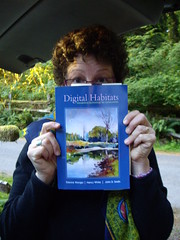On our FLNW tour I shared the proof with my traveling companions. Sylvia took this picture! I’m excited that Digital Habitats: stewarding technology for communities” is now PUBLISHED! You can find the early ordering details on the book’s blog site. It will be a while until it shows up on Amazon.
In case you are a new reader (and have not read my obsessions about the book over the years), here is the book info:
Technology has changed what it means for communities to “be together.” Digital tools are now part of most communities’ habitats. This book develops a new literacy and language to describe the practice of stewarding technology for communities. Whether you want to ground your technology stewardship in theory and deepen your practice, whether you are a community leader or sponsor who wants to understand how communities and technology intersect, or whether you just want practical advice, this is the book for you.
Written by Etienne Wenger, Nancy White and John D. Smith, the book brings together conceptual thinking, case studies and offers a guide for understanding how technology can help a community do what it wants to do. It gives a glimpse into the future as community and technology continue to affect and influence each other.
